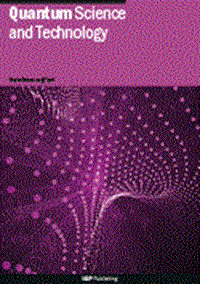偏微分方程的模拟量子仿真
IF 5.6
2区 物理与天体物理
Q1 PHYSICS, MULTIDISCIPLINARY
引用次数: 5
摘要
量子模拟器最初是为模拟一种偏微分方程(薛定谔方程)而提出的。量子模拟器也能高效地模拟其他偏微分方程吗?虽然偏微分方程的大多数计算方法--包括经典方法和量子方法--都是数字化的(必须先将其离散化),但偏微分方程具有连续的自由度。这表明模拟表示法更为自然。数字量子自由度通常用量子比特来描述,而模拟或连续量子自由度则可以用 qumodes 来捕捉。基于一种称为 "薛定谔化 "的方法,我们展示了如何将 D 维线性偏微分方程直接映射到 (D+1)- 量子量子系统上,从而在 D+1 量子量子系统上使用模拟或连续可变的哈密顿模拟。这种非常简单的方法不需要先将偏微分方程离散化,它不仅适用于线性偏微分方程,也适用于一些非线性偏微分方程和非线性常微分方程系统。我们用这种方法展示了一些例子,包括柳维尔方程、热方程、福克-普朗克方程、布莱克-斯科尔斯方程、波方程和麦克斯韦方程。我们还为具有随机系数的线性偏微分方程设计了新的协议,这在不确定性量化中非常重要,而模拟或连续变量框架显然是最自然的。这也提出了一种可能性,即某些偏微分方程可以直接在模拟量子系统上模拟,方法是使用这些量子系统的自然哈密顿。本文章由计算机程序翻译,如有差异,请以英文原文为准。
Analog quantum simulation of partial differential equations
Quantum simulators were originally proposed for simulating one partial differential equation in particular -- Schrodinger's equation. Can quantum simulators also efficiently simulate other partial differential equations? While most computational methods for partial differential equations -- both classical and quantum -- are digital (they must be discretised first), partial differential equations have continuous degrees of freedom. This suggests that an analog representation can be more natural. While digital quantum degrees of freedom are usually described by qubits, the analog or continuous quantum degrees of freedom can be captured by qumodes. Based on a method called Schrodingerisation, we show how to directly map D-dimensional linear partial differential equations onto a (D+1)-qumode quantum system where analog or continuous-variable Hamiltonian simulation on D+1 qumodes can be used. This very simple methodology does not require one to discretise partial differential equations first, and it is not only applicable to linear partial differential equations but also to some nonlinear partial differential equations and systems of nonlinear ordinary differential equations. We show some examples using this method, including the Liouville equation, heat equation, Fokker-Planck equation, Black-Scholes equations, wave equation and Maxwell's equations. We also devise new protocols for linear partial differential equations with random coefficients, important in uncertainty quantification, where it is clear how the analog or continuous-variable framework is most natural. This also raises the possibility that some partial differential equations may be simulated directly on analog quantum systems by using Hamiltonians natural for those quantum systems.
求助全文
通过发布文献求助,成功后即可免费获取论文全文。
去求助
来源期刊

Quantum Science and Technology
Materials Science-Materials Science (miscellaneous)
CiteScore
11.20
自引率
3.00%
发文量
133
期刊介绍:
Driven by advances in technology and experimental capability, the last decade has seen the emergence of quantum technology: a new praxis for controlling the quantum world. It is now possible to engineer complex, multi-component systems that merge the once distinct fields of quantum optics and condensed matter physics.
Quantum Science and Technology is a new multidisciplinary, electronic-only journal, devoted to publishing research of the highest quality and impact covering theoretical and experimental advances in the fundamental science and application of all quantum-enabled technologies.
 求助内容:
求助内容: 应助结果提醒方式:
应助结果提醒方式:


